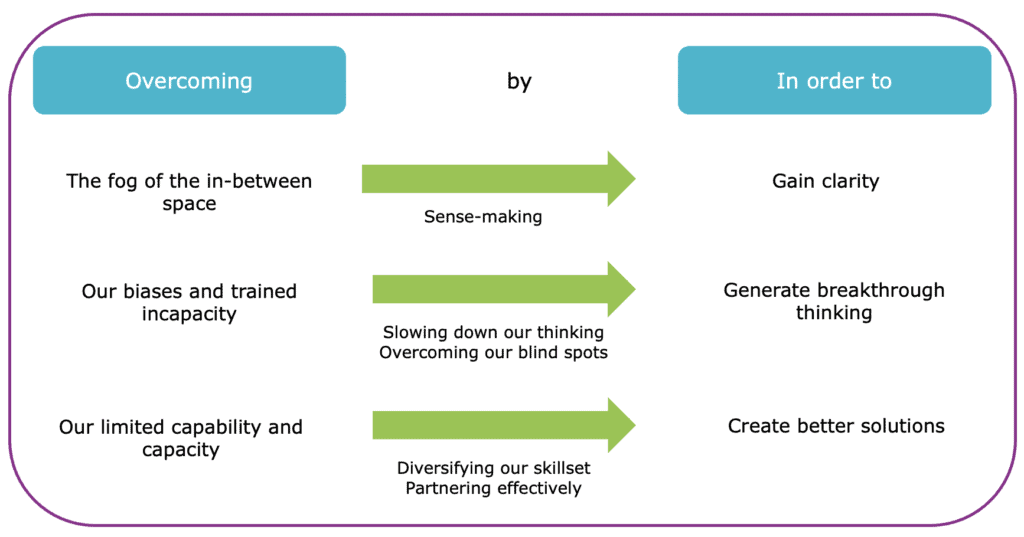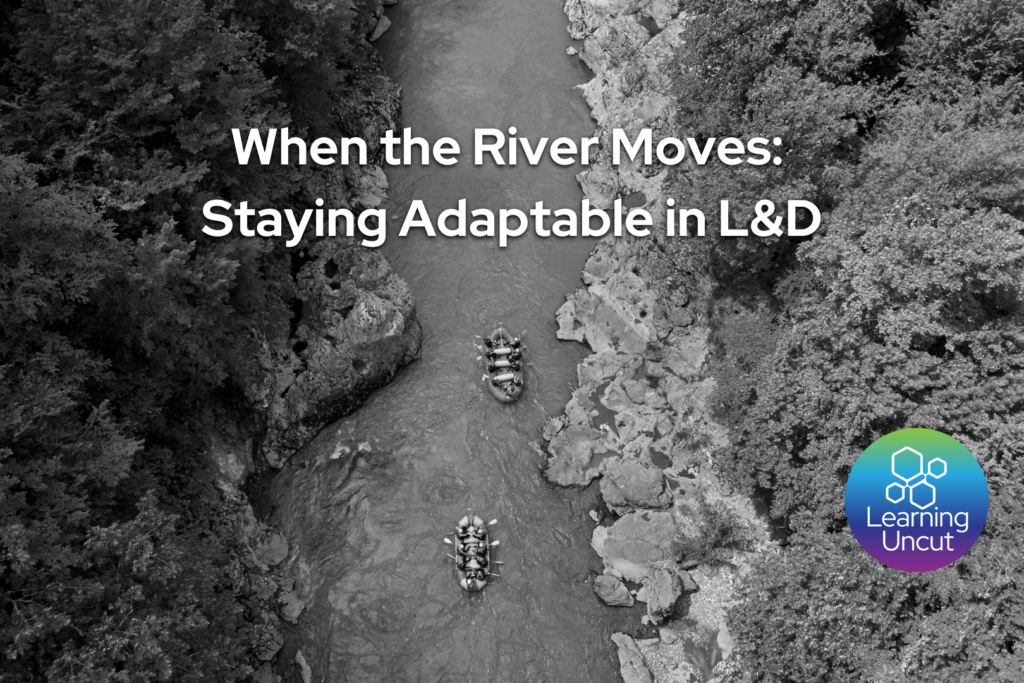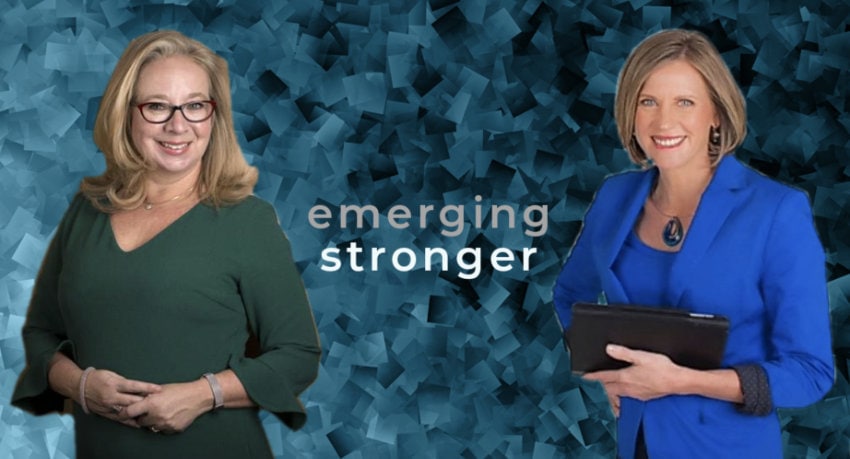L&D: Leverage Community to Carpe Diem
Chance favours the connected mind.
– Steven Johnson
Evidence amassed over the past 20+ years has pointed to fundamental shifts needed in traditional L&D practice to support better business outcomes. Yet, for the most part we’ve struggled to make these shifts. Now disruption in our lives and workplaces has ended many traditions, rapidly introduced new work arounds and left many working through the messy spaces in between.
There has never been a better time for L&D support change and to seize the day. How can L&D make the most of the opportunity presented by the ‘in-between’ space from pre to post COVID? How can we move beyond the spontaneity of seizing the day to actually harvesting the day wisely?
Adopting business value as your north star is a critical foundation. Even with the best intent to refocus on business value, the in-between space presents challenges to meet our aspirations. It’s time to start working smarter with the community around us.
Leveraging community is a sure-fire way to move from discomfort and uncertainty to creativity and action
Leverage community to harvest the day. Community is about harnessing the support, diverse perspectives and skills of others. L&D can leverage community to gain clarity, generate breakthrough thinking and create better solutions. Let’s explore how.

Gain clarity
2020 saw the acceleration of some shifts that were already underway, with remote working being the most obvious example. The parallel shift for L&D was from physical classrooms to online learning spaces. Even though the potential for this shift existed for many years, research by Fosway found that 59% of L&D professionals rated their organisation’s pre-covid approach to digital learning as immature.
It’s now clear that change in operating models is far from over – both in business and in L&D. As digital strategist Dion Hinchcliffe warns “It’s simply irresponsible and unacceptable to go back to the entirely too fragile and so easily-disrupted operating models of the pre-COVID-19 world.”
That both the shifts to remote working and digital learning could be undertaken so quickly reflects that they were already entirely within reach. The same can be said for enabling learning in organisations. A large-scale sense-making exercise is underway. L&D professionals must make sense of both what is shifting in business and how to adapt organisational learning to support this. Actively participating in communities is essential to sense-making and gaining clarity.
“Communities are our primary ‘sense-making’ entities: we use them to discover new information, share knowledge, and figure out what on earth is happening in the noisy world around us. We are effective through our communities, and we are held in the arms of our communities.”
Julian Stodd, The Community Builder
Generate breakthrough thinking
Drawing on the perspectives of others moves us beyond the limitations of our blind spots, be they due to cognitive bias or specialisation.
A cognitive bias is an inherent thinking ‘blind spot’ that impedes critical thinking and rationality. 180 cognitive biases have been codified – and this list is not exhaustive. Nobel prize winning psychologist Daniel Kahneman warns that even if we can identify our biases, at an individual level most of us have “no hope” of avoiding them. However, he offers a way forward. The quality of thinking can be improved in groups with the use of the right processes. Many of these processes, such as premortems or red team-blue team, work by slowing down thinking or structuring it to consider different aspects separately.
Specialised knowledge also generates blind spots, particularly in the face of changing circumstances. Economist Thorstein Veblen introduced the term trained incapacity over 80 years ago to describe “that state of affairs in which one’s abilities function as inadequacies or blind spots.” (Source: Robert King Merton (1968). Social Theory and Social Structure. New York: The Free Press, pp. 252)
Our expertise in traditional approaches such as courses and content limits our thinking and literally blinds us to other approaches.
It’s a double whammy for L&D professionals contending with blinds spots due to both cognitive biases and our own expertise. Our odds of generating breakthrough thinking increase when we interact with groups using processes to deliberately slow down our thinking and draw upon mental models from other domains.
“One of my big takeaways from behavioural economics is that we’re on automatic pilot for most of our lives. And when we’re on automatic pilot, one of the heuristics that we use to make quick decisions is using the herd… If you look at my Twitter channel you would not know what my politics are or what my anything is, because I follow such a diverse group of people.”
Arun Pradhan, Emergent podcast: Building Creativity and Innovation into the Future of Work
Create better solutions
The parable of the blind men and the elephant (if you’re unfamiliar with this parable, do an online search) tells us that multiple perspectives help us to see what is in front of us more completely. This is one of the reasons that progressive L&D teams co-design solutions. Bringing together different stakeholder perspectives is particularly helpful during analysis of a business problem or opportunity. Better diagnosis leads to better solutions.
Solutions that drive business value are often holistic. Not only must knowledge and skills be improved, but other levers may be required to change behaviours and improve performance. For example, systems, processes, resources, work patterns or environment, reward and recognition. L&D must partner with others to create better solutions.
Even the solution elements that L&D is directly responsible to develop and deliver require an increasingly broad, complex range of skills. These skills span strategy and operations, performance and impact, solution design and development, facilitating learning and supporting learning.
An individual or small L&D team cannot be proficient in all these skills. Even larger teams may be daunted by the breadth of capability now required. Partnering with others inside and outside of the organisation allows L&D to draw on supplementary capability and capacity as required.
In some cases (the value of partnership) can be outsourcing a small part of a training function, helping people either manage their investment, or help them with technology capabilities or things like that. And in other ways, it’s really managing the skills of people and to say how do we avoid over-investing in the people or technology without knowing what we want to do.
Shai Desai, Emergent podcast: Smarter Working Partnerships for L&D
Leverage Community to Harvest the Day
If you are ready to not only seize the day but truly harvest it to drive business value for the long-term, get connected to your community. Seek out diverse perspectives and skills to draw on inside and outside of your organisation. Actively engage in high quality sense-making and applied thinking to gain clarity in a reshaping world, generate breakthrough thinking about business challenges and create better solutions.
Get connected to your community. They are there for you.
Note: Originally published on Go1 blog.


